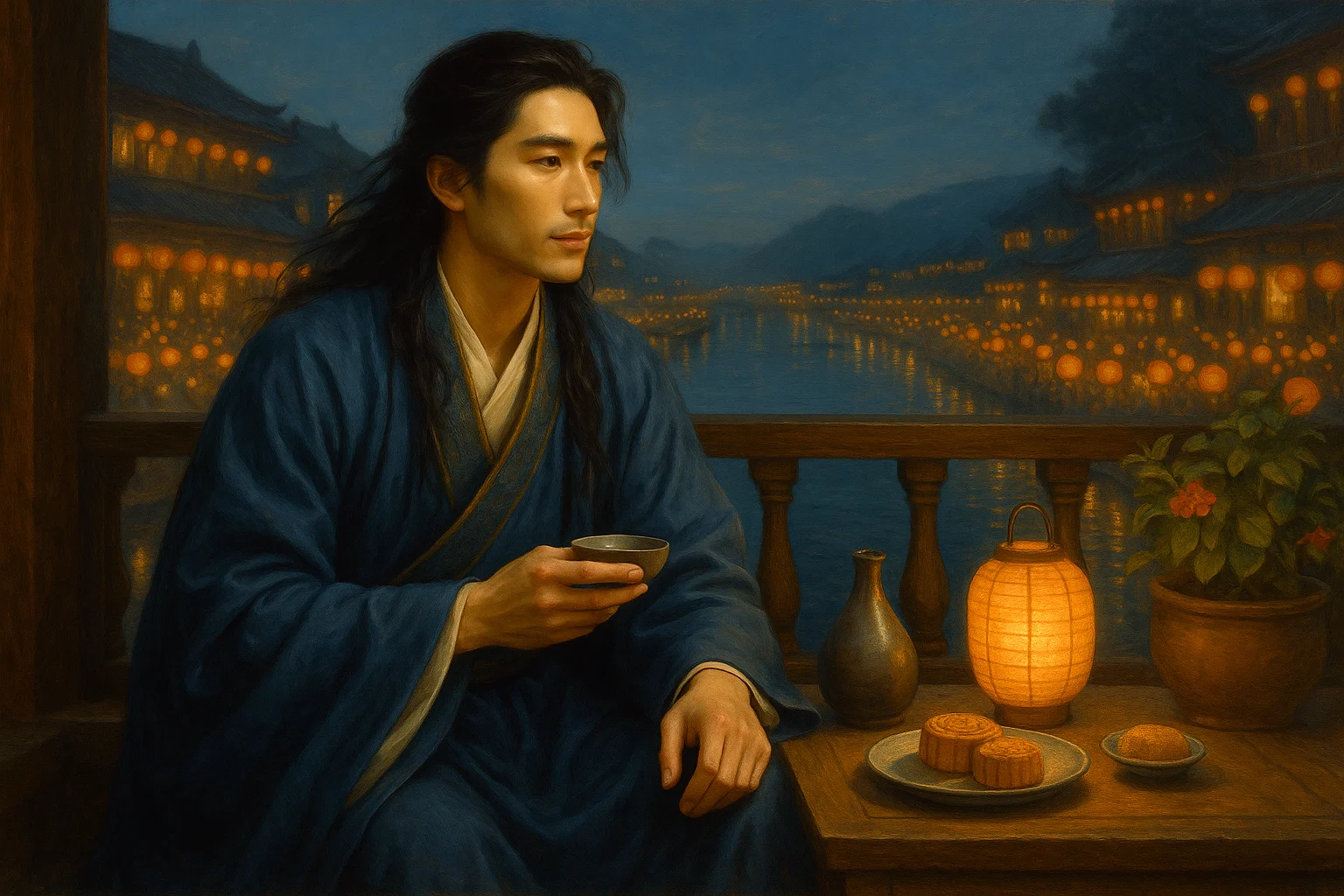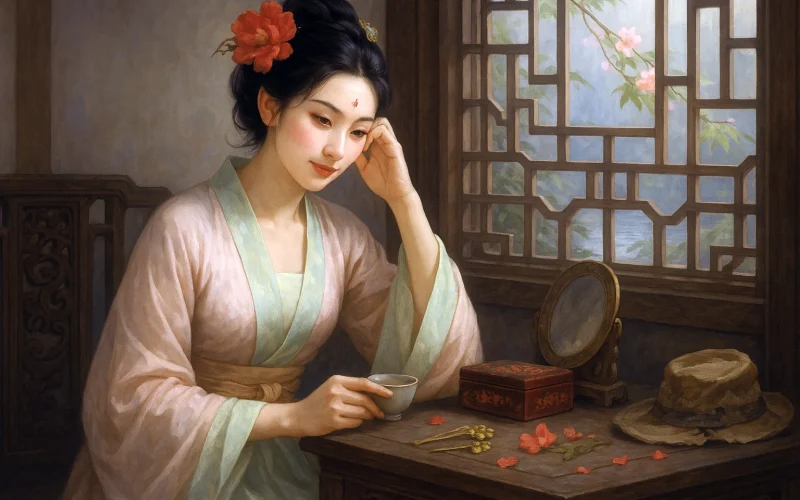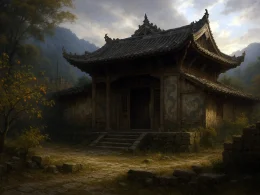Dust chokes low sun on the bureaucrat's plain,
Bian River's belly slumps like a wine stain.
Horizon eats our haste—
No sprint through such waste.
Horse-halt. First, graffiti archaeology,
Doorstep. Then, signboard anthropology.
Early lamps snuff—
Dreams pixelate the capital's bluff.
Original Poem
「浣溪沙 · 日薄尘飞官路平」
日薄尘飞官路平。眼前喜见汴河倾。
地遥人倦莫兼程。下马先寻题壁字,出门闲记榜村名。
周邦彦
早收灯火梦倾城。
Interpretation
This work depicts Zhou Bangyan's observations and sentiments during his travels, characterized by a light and unadorned style typical of "journey poetry." While the exact date of composition remains uncertain, it may have been written during his early official career while shuttling between Bianjing (Kaifeng) and other postings. Weary in body and spirit from the road, the poet finds solace in familiar sights—the Bian River, village name plaques—that offer unexpected comfort amidst fatigue. Through naturalistic scene-painting and understated emotion, the poem showcases Zhou's meticulous observational skills and his characteristically subtle, refined lyricism.
First Stanza: "日薄尘飞官路平,眼前喜见汴河倾。地遥人倦莫兼程。"
Rì bó chén fēi guān lù píng, yǎn qián xǐ jiàn Biàn hé qīng. Dì yáo rén juàn mò jiān chéng.
Sunset nears, dust swirls on the level post-road—
then joy: the Bian River's broad flow appears.
Though the way's long and weariness deep,
no need to press the pace.
The opening captures a traveler's twilight epiphany. "Dust swirls on the post-road" (尘飞官路) viscerally conveys road fatigue, while the Bian River's sudden appearance triggers quiet elation—a psychological turning point where geographical familiarity alleviates physical exhaustion. The concluding self-admonition "no need to press the pace" (莫兼程) reveals a Confucian ideal of measured progress, where restraint becomes both practical wisdom and philosophical stance.
Second Stanza: "下马先寻题壁字,出门闲记榜村名。早收灯火梦倾城。"
Xià mǎ xiān xún tí bì zì, chū mén xián jì bǎng cūn míng. Zǎo shōu dēng huǒ mèng qīng chéng.
Dismounted, I first seek inscribed wall-poems;
passing gates, I casually note village names.
Early to lamplight,
dreaming of that city of perfect grace.
The second stanza unfolds like a scholar's itinerary. "Inscribed wall-poems" (题壁字) represent the accumulated literary traces of previous travelers, their words forming a palimpsest of shared journeying. The act of "noting village names" (记榜村名) transforms mundane topography into personal literary geography. The closing "city of perfect grace" (倾城)—literally "toppling cities," metaphorically an incomparable beauty—hints at either a remembered beloved or the capital's allure, leaving the object of longing tantalizingly ambiguous.
Holistic Appreciation
This ci constructs a diptych of motion and rest, observation and reverie. The first stanza's dynamic movement (sunset, dust, river) gives way to the second's contemplative stillness (reading inscriptions, noting names, early retirement). Zhou's genius lies in making the traveler's pause feel not like surrender to fatigue but like conscious aesthetic choice—the "seeking" and "noting" are as purposeful as the earlier journeying.
The poem's emotional arc moves from physical relief (seeing the Bian River) to intellectual engagement (wall poems) to imaginative release (dreaming). Each stage represents a different mode of travel consciousness: wayfinding, cultural annotation, and subconscious wandering. The final "dreaming of that city of perfect grace" elevates the personal journey to mythic scale, whether referencing the legendary beauty that topples cities or the capital's own gravitational pull on the traveling official's psyche.
Artistic Merits
- Kinetic imagery:
"Dust swirls" (尘飞) and "river's broad flow" (汴河倾) create palpable movement contrasting with the second stanza's stillness. - Literary archaeology:
The "inscribed wall-poems" (题壁字) position the poet within a continuum of literate travelers, making poetry itself a form of waymarking. - Ambiguous climax:
"City of perfect grace" (倾城) masterfully conflates feminine beauty and urban grandeur, leaving interpretation productively open. - Confucian rhythm:
The poem's structure—active travel, contemplative pause, restorative sleep—embodies the ideal of balanced exertion.
Insights
Zhou's poem reveals journeying as layered experience: physical progression through space, intellectual engagement with culture, and emotional projection toward absence. His traveler isn't merely covering distance but composing meaning through selective attention—to rivers, poems, place names, and finally dreams.
For modern readers, the work models how travel transcends logistics when approached with aesthetic intentionality. The poet's "no need to press the pace" resonates in an age of relentless productivity, suggesting that true travel—whether geographical or existential—requires phases of purposeful deceleration.
Ultimately, the poem suggests that destinations matter less than the quality of attention we bring to the in-between spaces. Zhou finds poetry not just in the Bian River's grandeur but in dusty roads, village plaques, and the liminal state between lamplight and dreams—reminding us that meaning accumulates not only at journey's end but in its interstices.
About the Poet

Zhou Bangyan (周邦彦 1056 - 1121), a native of Qiantang (modern Hangzhou, Zhejiang), was the culminating master of the wanyue (graceful and restrained) ci poetry of the Northern Song Dynasty. A virtuoso in musical temperament, his ci are renowned for their opulent refinement and technical perfection. He created dozens of new melodic patterns (cipai) and adhered to strict tonal rules, earning him the title "Crown of Ci Poets." His influence extended to Southern Song masters like Jiang Kui and Wu Wenying, establishing him as the founding patriarch of the Rhymed Ci School.












